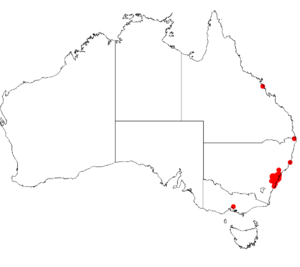Darwinia fascicularis facts for kids
Quick facts for kids Darwinia fascicularis |
|
|---|---|
 |
|
| Darwinia fascicularis at Ku-ring-gai Chase National Park, Australia | |
| Scientific classification | |
| Genus: |
Darwinia
|
| Species: |
fascicularis
|
 |
|
| Occurrence data from AVH | |
| Synonyms | |
|
Cryptostemon ericaeus F.Muell. & Miq. |
|
Darwinia fascicularis is a special kind of shrub that belongs to the myrtle family. It grows naturally only in areas near Sydney, Australia. This small plant has leaves that smell nice and its flowers are white, but they turn red as they get older. Birds that feed on nectar love to visit its flowers for food.
Contents
What It Looks Like
Darwinia fascicularis is a lovely plant that can grow up to about 1.5 to 2.5 meters (5 to 8 feet) tall. Its light green leaves are like small needles, smooth, and almost round. They are about 8 to 16 millimeters (0.3 to 0.6 inches) long. The leaves grow close together, either opposite each other or in circles around the spreading branches.
The flowers look like a pin-cushion. They grow in groups of 4 to 20 at the end of the branches. They start white and then change to red as they get older. Each flower has a long, thin part called a style, which is straight or curved and about 12 to 18 millimeters (0.5 to 0.7 inches) long. These styles can be white or red.
Small, leaf-like parts called bracts are found near the flowers. They are thin and see-through, about 2 to 14 millimeters (0.08 to 0.5 inches) long. The flowers themselves are shaped like tubes, about 5 to 7 millimeters (0.2 to 0.3 inches) long. The plant usually blooms from June to September.
How It Got Its Name
The plant Darwinia fascicularis was first officially described in 1816 by a person named Edward Rudge. Its scientific name, fascicularis, comes from a Latin word, fasciculus, which means "a little bundle." This name was chosen because the leaves often grow in tight groups or bundles at the ends of the branches.
Different Types of Darwinia fascicularis
There are two main types, or subspecies, of Darwinia fascicularis:
- Darwinia fascicularis subsp. oligantha
This type was described in 1962 by Barbara Briggs. It is a smaller shrub, usually growing only to about 30 centimeters (1 foot) tall. Its branches often spread out along the ground and can even grow roots if they touch the soil. This subspecies usually has only 4 flowers in a cluster, sometimes 2 or 6. Its leaves are a darker green and not as crowded. You can find it in higher areas of the Blue Mountains in New South Wales, often in rocky or sandy soil. The name oligantha comes from ancient Greek words meaning "few flowers."
- Autonym: Darwinia fascicularis subsp. fascicularis
This is the more common type. It grows upright and can reach about 2 meters (6.5 feet) tall. Its branches do not grow roots when they touch the ground. This subspecies has more flowers, usually 4 to 20 in a tight cluster. It grows along the coast from Gosford to Bulli near Wollongong, usually within 30 kilometers (19 miles) of the ocean. It likes sunny spots on the edges of sandstone hills, often in heathland or dry scrub areas below 500 meters (1,640 feet) in height.
Where It Lives
Darwinia fascicularis grows in a stretch of land from Gosford in the Central Coast area down to Bulli near Wollongong. It prefers poor, sandy soils and can be found in dry eucalyptus forests or heathlands, especially in places that get a lot of rain.
Good for Gardens
This Darwinia species is quite tough and can be a great addition to a garden. It likes open, sunny spots with soil that drains well. Many native birds are drawn to this plant because its flowers are a good source of nectar. These include birds like the New Holland honeyeater, the tawny-crowned honeyeater, and the eastern spinebill. Scientists believe that birds are the main helpers in pollinating this type of Darwinia plant.

